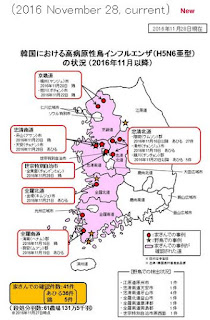 |
| CREDIT - MAFF |
#11,959
The headline from the English edition of today's JoongAng Daily reassuringly states Avian flu strain won’t infect humans says KCDC - and while that may well prove true - based on the actual press release from the Korean CDC, all of the evidence isn't in.
Four paragraphs into the report, the news article states:
The KCDC announced Wednesday it will carry out artificial infection experiments to evaluate health risks associated with the avian flu, which will be completed in March.
As of now, a total of 1,549 individuals, mostly owners of affected farms, are at the highest risk of infection. Local health authorities will monitor them during the 10-day incubation period.
What the Korean CDC actually said (the full translated report follows) is that genetic analysis didn't turn up any obvious red flags; amino acid changes in the virus that are known (or suspected) to increase the risk to mammals.
Given the thousands of people likely exposed to H5N6 infected birds in China and Vietnam over the past couple of years - and only 16 known human infections - its pretty much a given that the risk of infection is low.
As you'll see, the standard cautions with regard to exposure to H5N6 are still very much in place.
The public is urged to avoid livestock farms and migratory birds, `completely follow personal hygiene regulations', and report any flu-like illnesses to public health officials that appear within 10 days of possible contact with wild or infected birds.
Additionally, the CDC has established a 'Central H5N6 AI Human Infection Response Team' and have developed procedures for dealing with any suspected human infection.
Domestic outbreak of H5N6 AI virus, very low possibility of human infection
◈ Domestic outbreak of H5N6 AI virus,
① Pathogenic gene similar to existing virus and human infection
② No antiretroviral resistance gene is available
◈ Strengthening local government response and high risk management in accordance with AI spread
□ The Disease Control Headquarters (Head of the Division) and the National Institute of Health (Director Park Do Joon) compared the H5N6 avian influenza virus genome * confirmed in Korea with viruses identified in other countries, There is no mutation, and it is said that an animal infection experiment is under way to directly evaluate the risk of human infection such as the virulence of the virus.
* Domestic H5N6 virus full-length genes (4 cases) were received from the Agriculture, Forestry and Livestock Quarantine Headquarters and the College of Veterinary Medicine of Konkuk University (Professor Song Chang-sun)
□ The National Institutes of Health has not observed any further changes related to human infection and pathogenicity compared to isolated viral genes in China, Vietnam, Laos and Hong Kong so far from the H5N6 AI virus genome * isolated from poultry and wild migratory feces At the gene level,
In particular, the virus isolated from the Ministry of Agriculture, Forestry and Livestock has been found to contain a PA gene * derived from Eurasian pathogenic AI, but the major genes associated with increased pathogenicity in mammals have not changed.
* The PA gene is involved in the replication and proliferation of viruses, and certain mutations in this gene affect the pathogenicity of mammals
He also explained that there is no genetic mutation in the case of resistance to antiviral agents * used for AI prevention and treatment.
* Oseltamivir (Tamiflu, etc.), Zanamivir (Relena etc.) and Amantadine
○ In order to directly evaluate the pathogenicity and the risk of human infection of avian influenza virus with frequent gene mutation, we are conducting an infection experiment using mammals such as mice and weasel in the biological safety facility (BL-3) .
□ In order to respond quickly to AI human infectious diseases, the Disease Control Headquarters is operating the 'Central H5N6 AI Human Infection Response Team' from November 11th, and dispatches epidemiological investigators to the 24-hour emergency room operation and disposal site, And provides expert technical support for preventive management of infection countermeasures.
○ As a result of the recent spread of AI spreads, the total number of 1,549 persons *, including the disposal participant and the farm worker, classified as high risk * as of November 29, and the relevant public health center has applied antiviral prophylactic medication, Day) 5th, 10th day Active monitoring monitors the occurrence of symptoms such as fever,
* 197 farmers, 1,021 livelihoods, 228 respondents, 103 forclains, etc.○ In response to suspected cases, we have established a response system such as a rapid epidemiological survey and prepared and responded to the country's designated sound pressure bed by region for isolation treatment.
□ The Disease Control Headquarters recommends that cities and provinces, municipalities, and counties continue to strengthen their management and supervision in order to ensure that preventive measures against AI infection are thoroughly implemented in the field,
* Tuesday, November 29 10:30. Holding of AI countermeasure meeting* On November 29 (Tue), 15:30, city and provincial epidemiological investigator and officials in charge, AI response to infectious disease management headquarters
○ AI In order to prevent human infection, it is important to actively cooperate with the public.
- Do not visit livestock farmers or migratory birds,
- Completely follow personal hygiene regulations such as hand washing for more than 30 seconds,
- If you have contact with wild birds or have respiratory symptoms such as fever, muscular pain, coughing, sore throat within 10 days after participating in the work related to disposal of flesh, you should immediately report to the Public Health Center or the 1339 (24 hours working Disease Control Center call center).
□ According to the AI situation, the Disease Control Headquarters will work closely with the livestock sanitary authorities and local governments to prevent AI human infection and to prepare for the occurrence of the disease.